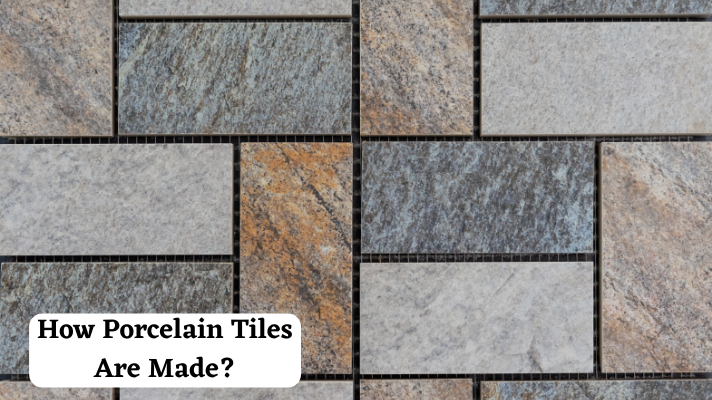

By the late nineteenth century, and with the Industrial Revolution, commercial manufacturing of tiles was at its peak, making it more accessible to everyone. With the desire and necessity for new developments in ceramics, innovative production and design concepts evolved, and new doors arose to discover different ceramics; finally, with each new advancement, Porcelain Tiles emerged as the Next Big Thing in Ceramic Tiles.
Natural clay is the main component of the Porcelain Tiles construction, which is combined with various minerals. Porcelain tiles are made of extremely fine clay and are first processed at very high temperatures. This treatment gives the Tile several distinguishing properties like as much reduced moisture absorption, excellent composition, and the requisite toughness to withstand all types of purposes.
Porcelain tiles are ideal for high-traffic areas such as hallways, stairways, public settings, and retail spaces since they demand little or no maintenance. The tiles' durability makes them suitable not only for indoor but also for exterior usage; their rustic colors and capability to imitate real stones make them a sensible alternative for exteriors and are built to withstand practically any unfavorable environment.
Porcelain tiles are created of finer clay which is burned at extreme heat to eliminate water and create a durable, thick tile. Porcelain tiles are solid and long-lasting, with a moisture retention rate of less than 0.5 percent.
Porcelain tiles are vitrified tiles made by adding materials such as quartz, silica, or feldspar to a clay mixture. This leads to decreased permeability and reduced water retention, rendering the tiles tougher and able to withstand greater forces.
The process of manufacturing porcelain tiles involves the following phases:
Batching estimates are applied to determine the right proportion of each raw ingredient in order to produce the ideal raw material mixture. The quantity and kind of natural resources used in several porcelain items affect the body composition. The raw ingredients influence the color and stiffness of the tile’s composition. As a result, it is critical to blend the correct proportions to create the desired qualities.
To achieve a water-filled composition of the mixture, which is known as Slip, all components, such as clay, feldspar, silica, sand, and so on, are ready, they are loaded together into a massive blender known as a ball mill. Throughout the blending procedure, a specified volume of water is introduced. To aid the blending operation and crush the materials into smaller particles, ball gravel or aluminum pellets are introduced to the ball mill.
The third phase of the manufacturing process can be is optional as it involves adding color to the blend or the slip. The blending is done in a high-speed blunger tank. For a basic body having organic body color, this phase may be skipped.
The spray dryer is used to drain surplus moisture from the slip. The slip is pumped into an evaporator made up of nozzles during the procedure. As the slip droplets are blasted by ascending heated air, the water in them evaporates. The fluid slip would then become powdered.
The tile that is created in the following step is known as the green tile. It is created by the dry press method where the dried slip powder is formed into a die. A metal piston compresses the blend at an intense pressure of above 7,500 tonnes, resulting in a compressive force of over 400kg/cm2. The goal of the procedure is to create a more dense and permeable porcelain structure, which leads to a robust shell and exceptionally low water retention after fire treatment.
In this phase, the green tile is dried to eliminate surplus water at a moderate rate and in a considerably high humidity environment to minimize shrinkage cracks.
Following the drying of the green tiles, the following stage is to add graphics and designs with laser inkjet to encompass the core color and provide the intended result, and texture on the tiles. This procedure will also increase the tile's stain protection and provide it with a distinctive pattern. Then, a layer of glaze material is placed on top to give moisture resistance and beauty, since they may also be colored or used to make the distinctive texture.
The tile is next fired in a roller kiln at extraordinarily elevated temperatures of up to 1200°C. The high temperature will aid in the setting of the glazing and the removal of any leftover water, changing the soft clay into a firm, resilient, and non-porous tile.
This is the process of grinding and polishing tiles to give them a lovely glossy shine. Tile can be treated to a shiny mirror surface by varying the degree of polish and the use of primary difference instruments. The margins of the completed tile can be corrected or unrectified.
Porcelain tiles were manufactured for countless generations across the world and are frequently for use on flooring and wall cladding due to their low moisture absorption, elegant look, and simple upkeep properties that make them very flexible.
Today, producers all over the world have drastically improved the appearance and durability of porcelain tiles by upgrading their pattern, manufacturing techniques, and technology. Porcelain tile's high density makes it appropriate for moderate to heavy usage areas in both domestic and business environments.
If you are looking for the best porcelain tiles manufacturer in India, consider Rollza Granito.
Get in touch with us via call or email - +91 99790 55557 / info@rollza.in